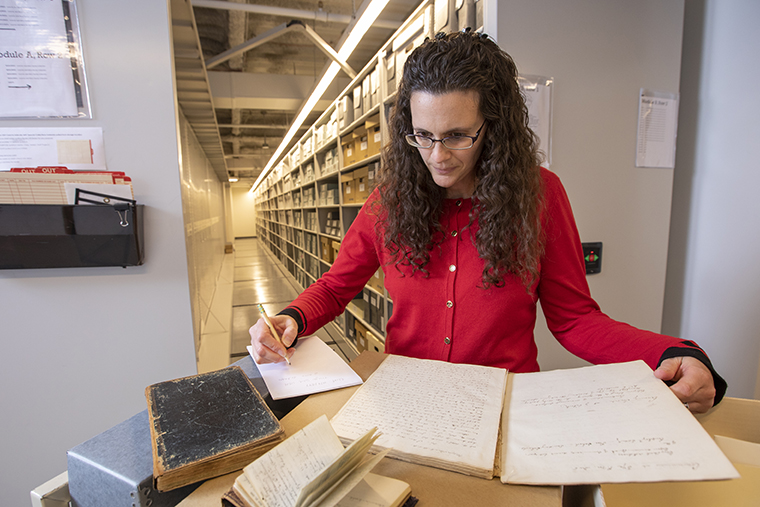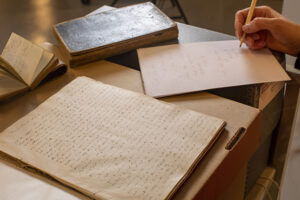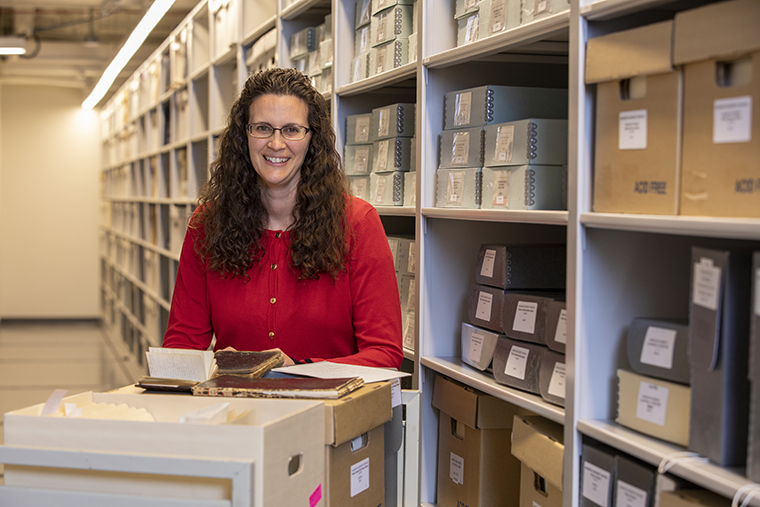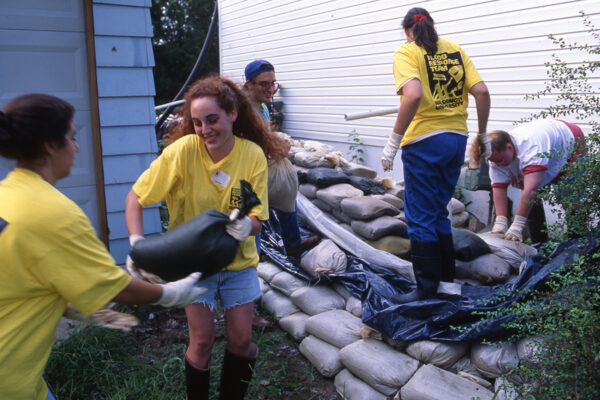On the afternoon of Oct. 3, anticipation and excitement was palpable on the Danforth Campus as the time neared for the inauguration of Andrew Martin as the 15th chancellor of Washington University in St. Louis.
At about 2:30 p.m., as Brookings Quadrangle began filling with students, faculty, staff and guests, ceremony participants lined up by Eads Hall while waiting to proceed into the Quad for the historic event. Second in line, behind Grand Marshall John Druback, was Sonya Rooney, university archivist. Rooney was chosen out of more than 15,000 university employees to be among the first of Washington University faculty, staff, students, guests and delegates to proceed into the Quad. Rooney walked in with the university charter in her hands.
“It was exciting to be among the first in the processing line,” Rooney said. “There was a sense of anticipation and happiness in the crowd and among the others processing in.”
As archivist, Rooney was given the honor of carrying the ceremonial university charter through the arches of Ridgley Hall and across the Quad’s cobblestone walkway to the stage in front of the Cupples I building. She climbed the stairs, sat up on the stage with the other dignitaries, and waited for the moment in which she would hand the charter to Andrew E. Newman, chair of the Board of Trustees, who would then give it to Martin.
The ceremonial charter, which lives in University Archives, was created in 1995 for the inauguration of Mark S. Wrighton, using the language of the university’s original charters in 1853 and 1856. It is a hand-crafted broadside designed by Douglas Dowd, professor of art and of American culture studies, and Sarah Spurr, former associate professor of art. This combination of hallowed tradition and innovation was symbolic of Martin’s chosen inauguration theme, “Momentum,” as well as the belief that Washington University would continue to combine old and new to be a leader in the St. Louis region as well as the world.
“I am the charter’s caretaker,” Rooney said, “so I got to take care of it during the inauguration, too.”
It wasn’t her only inauguration duty. Rooney also planned Olin Library’s inauguration exhibit “Momentum: Bridging Past, Present, and Future,” which remained on view throughout the fall semester. The exhibit included original drawings of the Eads Bridge, which Martin used to illustrate his inauguration remarks. The exhibit also highlighted stories that reflected on aspects of the university’s history, which Martin spoke of at various events on campus and in the community in his first months as chancellor.
Included in the display were Carl and Gerty Cori’s Nobel diploma for their research on a body’s ability to convert glycogen into glucose; and photos of the Washington University Flood Response Team, which was formed in response to Missouri’s Great Flood of 1993. Rooney’s goal with the exhibit was to show the continuity in university leadership and community engagement, while sparking interest in other documents in the John M. Olin Library Julian Edison Department of Special Collections.

Everyday moments
As Rooney will tell you, being a university archivist is about more than participating in high-profile events. It’s about the everyday moments of cultivating the university’s institutional history and helping patrons find answers to their research questions in the archives.
It was everyday moments in her hometown of Hoxie, Kan., that first got Rooney interested in history. She recalls participating in National History Day competitions on the local, state and national level in high school, where she conducted oral history interviews and did research in archives.
“The oral histories and archival research for National History Day really made history come alive for me,” Rooney said.
These competitions required participants to use primary sources, complete annotated bibliographies and develop a 10-minute slide presentation. Through this project, Rooney was able to learn research skills and the value of primary sources, both tools that have provided a strong foundation for her career as an archivist.
Among the subjects for which she recalls conducting interviews and primary source research at different libraries were her pastor, who grew up in the Philippines during World War II before moving to the United States; a Catholic priest who grew up in Vietnam who came to America during the Vietnam War; the impact of ham radio; and a Kansas woman who influenced her husband to vote for Prohibition in the state legislature during the 19th century.
At Bethel College in North Newton, Kan., Rooney said she briefly considered becoming a history teacher but realized she did not want to teach full-time. After earning her degree in history from Bethel, she came to St. Louis to pursue a master’s degree in history with a concentration in museum studies at the University of Missouri-St. Louis. Archival internships at the Harvey County (Kan.) Historical Society, the Western Historical Manuscript Collection and the Missouri History Museum (St. Louis) made her realize that her true passion was in archival work.
St. Louis grew on her; she decided to stay in the area and was hired by Washington University in 2002, working in the manuscripts collection in Special Collections before being promoted to university archivist a few years later.
Rooney finds institutional history, which is the study of how businesses, universities or other organizations evolve over time, especially interesting. “I’m drawn to institutional history because I like learning about them and how they impact people that interact with them,” she said. “Washington University is a prime example of an institution with a rich history since it was founded in 1853 and is so connected to the history of St. Louis.”

This interconnection between Washington University and St. Louis is evident in Rooney’s favorite collection, the William Greenleaf Eliot Personal Papers, housed in the Julian Edison Department of Special Collections. There, researchers can see the correspondence, sermons, speeches, writing, photography and diaries of the Unitarian minister who co-founded the university.
Eliot was an early example of the university’s involvement in the St. Louis community, Rooney said, as he took on many progressive causes such as strengthening the St. Louis Public School system, emancipation and women’s rights.
“Eliot’s papers are great examples of personal and institutional history that gives readers the context of the time in a broader picture,” she said.
Rooney was happy to work with Eliot’s great-great-grandson, Frank C. Eliot, who enthusiastically donated additional material to the university, including two more of his ancestor’s diaries.
“I was amazed that he was still finding material from Eliot and then was willing to share with us,” Rooney said. “It enriches the collection we have here.” She said primary sources, such as those provided by Eliot’s great-great-grandson, play an important role in developing institutional history because they add depth to existing scholarship and further contextualize events.
And when supporting documents such as Eliot’s diaries are still in existence, all the better. “It helps the institutions see where they have come from, and can help shape the present and future,” Rooney said.
Institutional history also allows alumni to connect with the shared parts of their past, and it plays an important role in the university’s milestone celebrations, such as Olin Business School’s recent centennial and the School of Law’s 150th anniversary. These opportunities allow Rooney to collaborate with people from across the university to help share its rich heritage.
Rooney also makes institutional history and archival records available to the broader community to ensure accessibility, and she finds that one of the most rewarding aspects of her job is helping researchers, both on-site and remotely, answer their research questions and find joy in history.
“I like providing treasure hunters with the right map to answer their research questions,” she said.
When working with students, Rooney tries to find connections between their passions and what sources are found in university collections, having them access physical archives personally to experience this history. The future of archival work and institutional history, she said, depends on preserving and making accessible our records and maintaining digital files and social media.
Outside of the library, Rooney loves spending time with her family, including her husband, Rob; 11-year-old daughter, Rachel; and Goldendoodle, Sandi. They also love experiencing all the great amenities that St. Louis has to offer, such as the Saint Louis Zoo and the Saint Louis Science Center.


